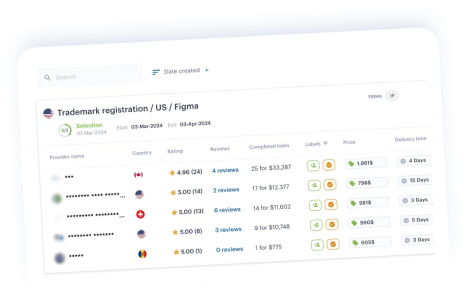Why Excel and Agencies Break as You Grow
In the early days, managing a few patents in Excel seems perfectly fine. But once your portfolio starts expanding, the system collapses under its own weight. What once looked “simple” quickly turns into endless versions of spreadsheets, conflicting calendars, and chaotic email chains.
Every missed reminder can turn into lost rights, penalties, or reputation damage.And when each update depends on a single person or agency, you lose visibility and control.
This article explains how modern patent docketing software helps growing teams bring order to complexity by removing chaos, automating deadlines, and scaling operations without hiring an army of coordinators.
What Is Patent Docketing Software and How It Differs from an IPMS
Patent docketing software is a specialized digital system designed to keep intellectual property (IP) portfolios organized and compliant.
It acts as the operational backbone of an IP team, tracking every deadline, filing, and communication related to patents — from the first application to renewal.
While docketing systems focus on precision and control of processes, a full IP Management System (IPMS) covers a wider spectrum: budgeting, analytics, renewals, collaboration, and strategic decision-making.
In essence, docketing software ensures nothing is missed, while IPMS ensures everything is connected.
Core Modules of Patent Docketing Software
1. Case Management (Dockets)
This is the foundation of the system. Each intellectual property right — a patent, PCT application, trademark, or design — is represented as a case record (docket) containing all relevant data:
- Application number, jurisdiction, filing and publication dates
- Inventors, owners, and representatives
- Current procedural status (filed, under examination, granted, etc.)
- Linked deadlines, documents, and correspondence
Case management allows users to search, filter, and view the full history of each matter in seconds, replacing manual spreadsheets and fragmented records.
It creates a single source of truth for the entire portfolio.
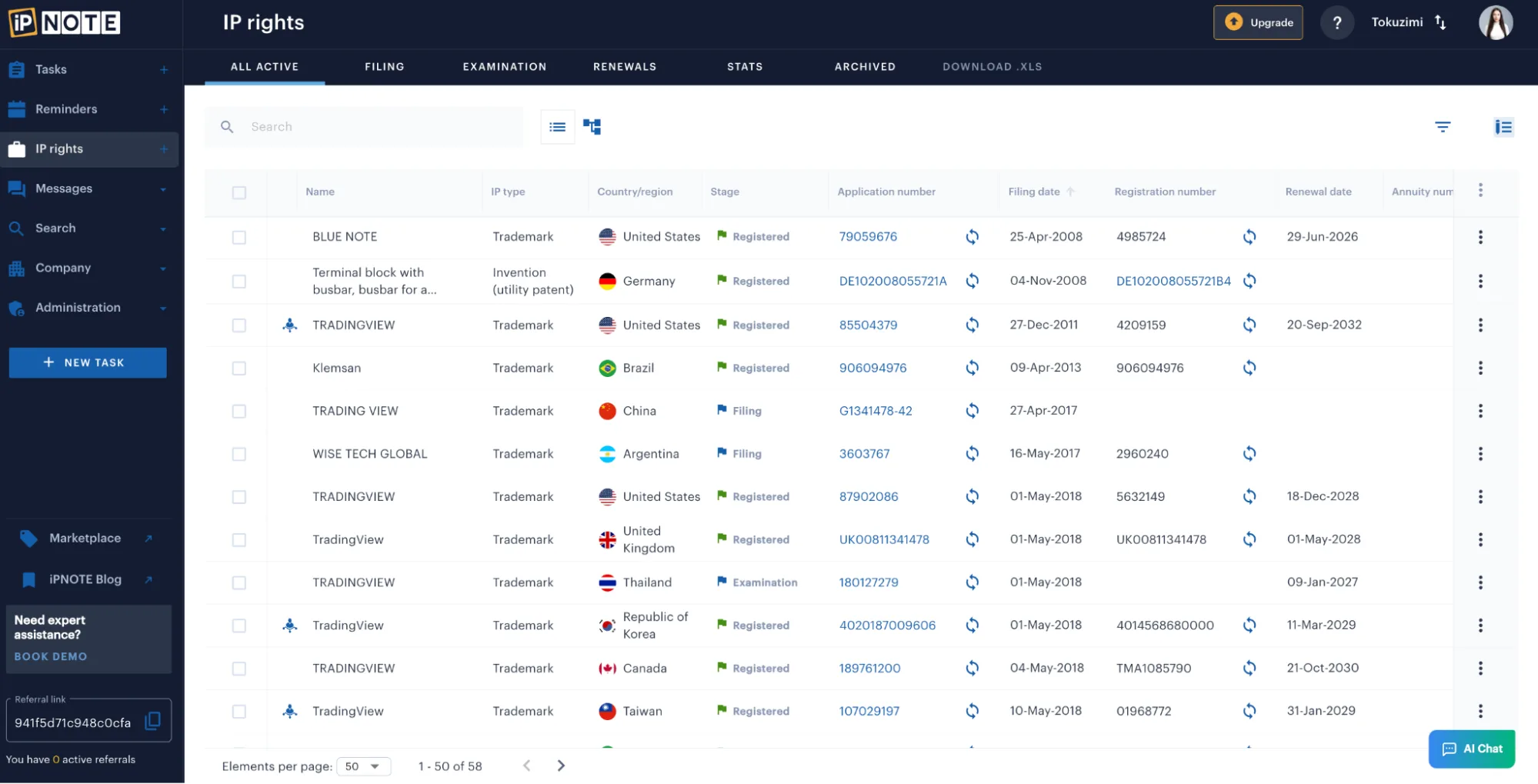
2. Deadlines and Task Reminders
Deadlines are the heartbeat of patent management, missed dates can mean lost rights.
Instead of a traditional calendar, the iPNOTE task management module automatically creates a task for every key deadline in your portfolio.
Each task is linked to a specific case and jurisdiction and follows procedural rules for that IP type, whether it’s a response to an Office Action, national phase entry, renewal payment, or priority filing.
As each deadline approaches, you’ll receive email notifications and in-platform reminders, ensuring no critical action is overlooked.
All upcoming reminders are conveniently displayed in a dedicated task overview window, allowing you to track due dates and manage workload efficiently.
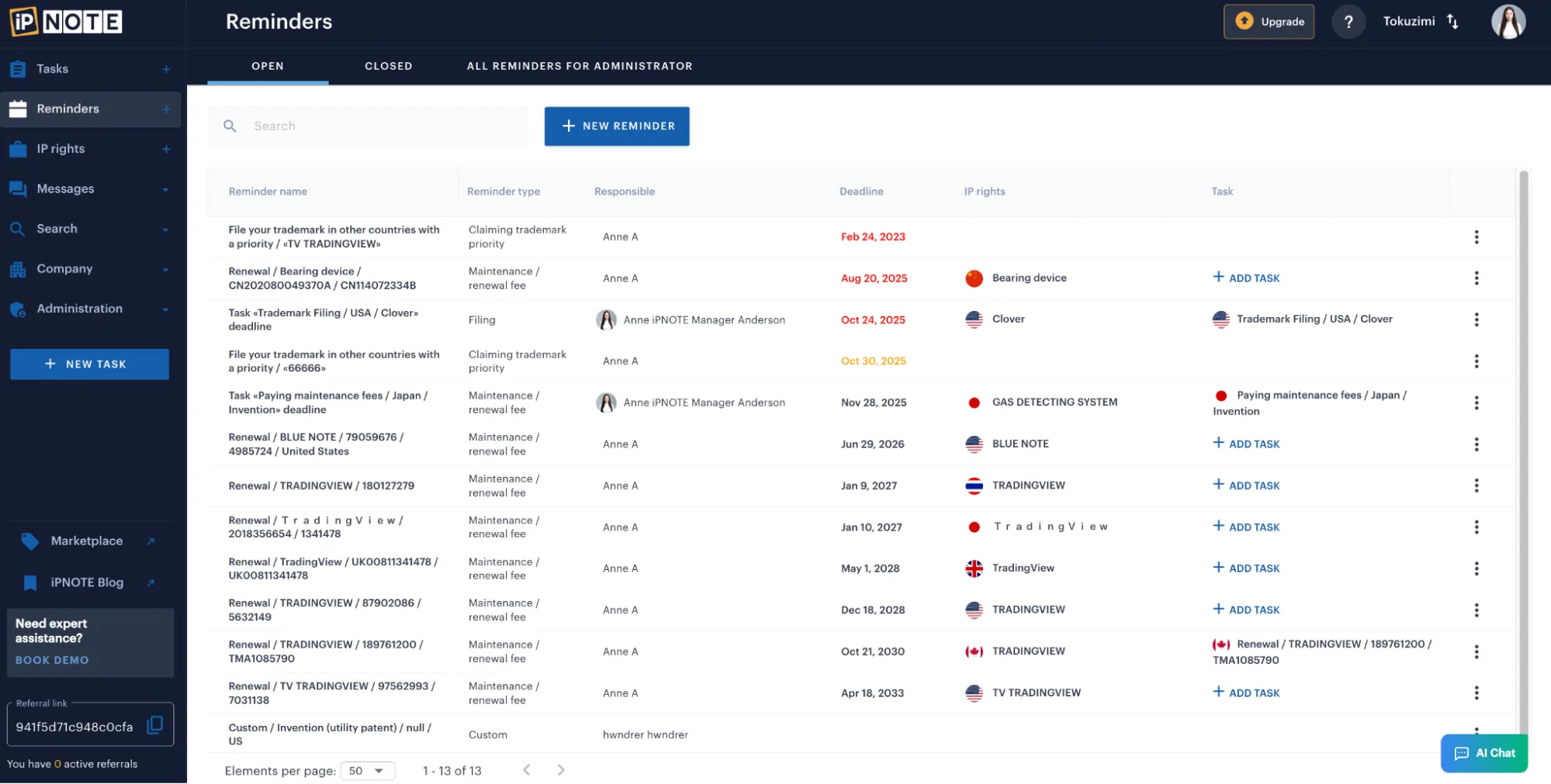
3. Document Management
Every filing, communication, and official document generated during a patent’s lifecycle is stored in the system:
- Application forms, patent drawings, and specifications
- Office Action notices and responses
- Assignments, powers of attorney, and fee receipts
- Correspondence with patent offices and agents
Modern docketing tools support version control, meaning users can view or restore older document versions and see who uploaded or edited a file.
This replaces scattered email attachments with a secure, centralized archive linked directly to each case.
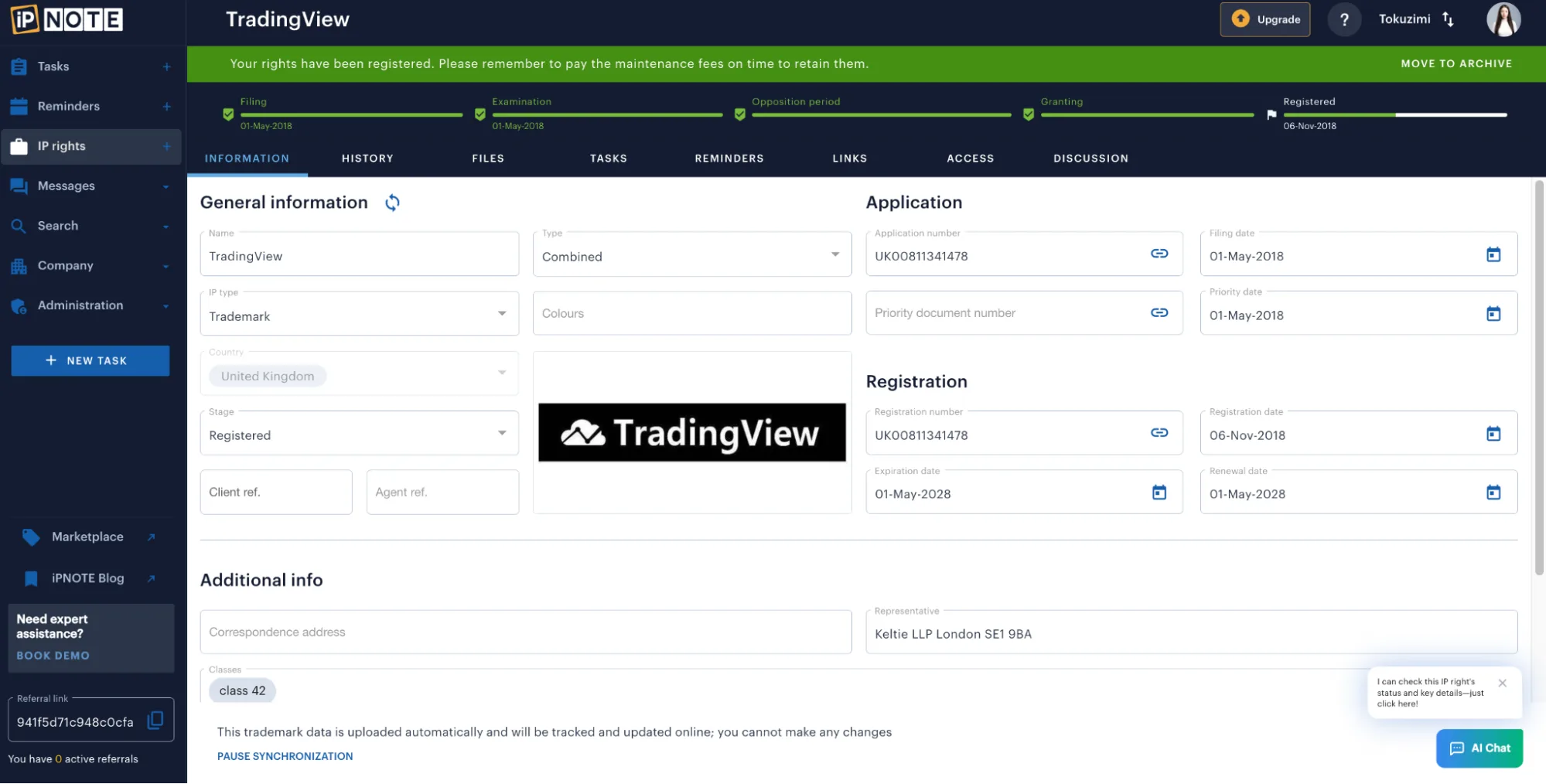
4. Roles, Access, and Collaboration
A good docketing system defines who can see and do what.
Role-based access control (RBAC) assigns visibility and permissions to users depending on their position:
- Paralegals may update case data and upload files.
- Attorneys can approve filings and responses.
- External agents can view assigned matters but not internal notes.
- Finance teams may see cost and renewal data only.
This structure keeps sensitive IP information secure and ensures clarity of responsibility within large legal departments.
5. Reporting and Audit Trails
Beyond daily task management, docketing systems provide reporting and analytics tools for managers and compliance officers:
- Lists of upcoming deadlines or overdue tasks
- Portfolio summaries by jurisdiction, owner, or product line
- Complete audit logs showing who changed what and when
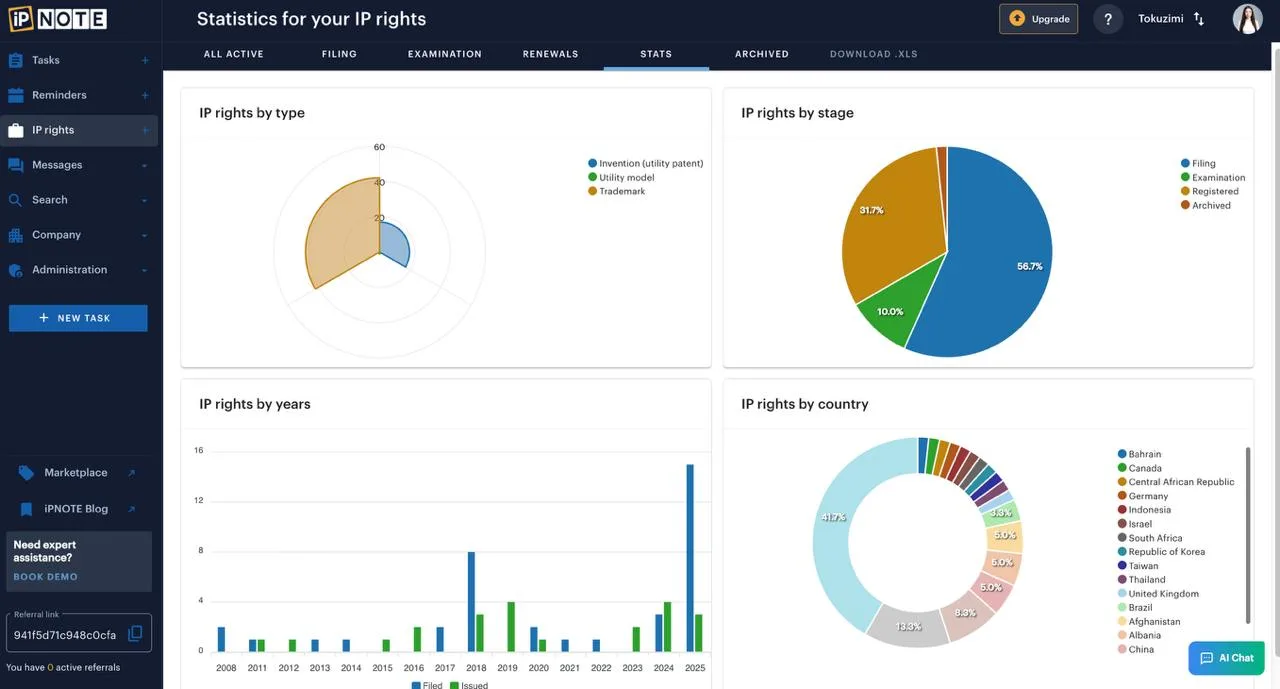
Docketing vs. Full IPMS: Where the Boundary Lies
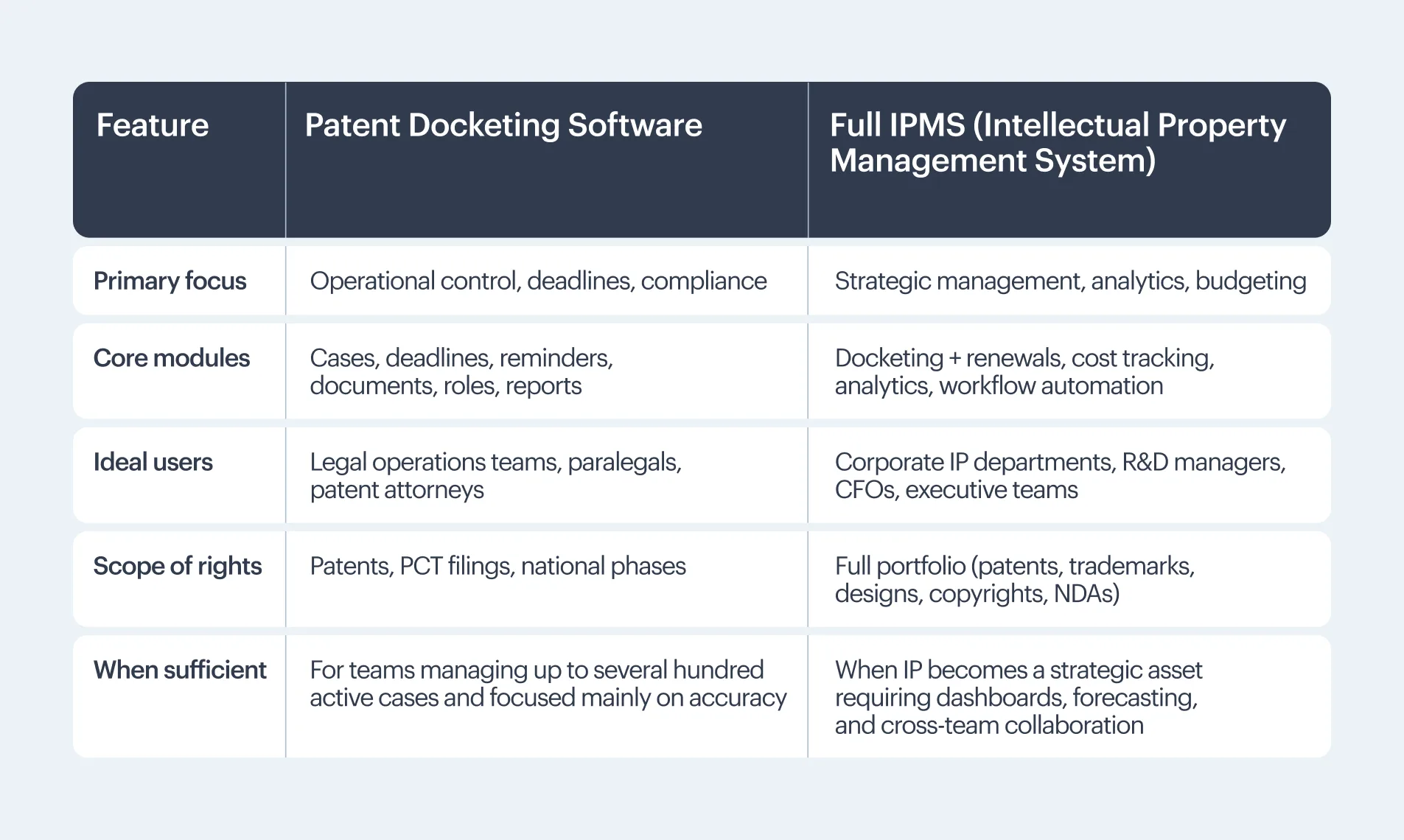
Where the Practical Line Is Drawn
In practice, patent docketing software is perfect when the main challenge is volume and precision — tracking deadlines for PCT applications, national phase entries, or periodic renewals.
It keeps the operation compliant and efficient.
A full IPMS becomes necessary once an organization needs to connect IP operations with finance, R&D, and executive reporting — integrating renewal costs, forecasting, analytics, and interdepartmental workflows.
Think of docketing as the engine room and IPMS as the control tower:
one keeps the system running on time, the other helps steer long-term strategy.
Where Manual Tracking Fails: The Five Breaking Points
Even the most organized teams hit a wall once they rely too long on manual tracking. Spreadsheets and email threads can only stretch so far and here’s where they usually break.
1. Scattered Calendars and Excel Chaos
Each person has their own version of a spreadsheet, and every version is “the latest one.” Deadlines shift, data goes missing, and nobody can say for sure what’s accurate. A single miscalculated date or mistyped case number can cause months of delay or even lost rights. Docketing software centralizes everything in one shared database — a single, reliable calendar that updates automatically and never forgets.
2. Ignored Local Rules and Date Shifts
Each jurisdiction plays by its own rules. Holidays, office closures, and national regulations constantly change, and Excel doesn’t know how to keep up. The best docketing systems rely on jurisdictional rule libraries that automatically adjust deadlines based on location, type of filing, and procedural stage, ensuring that every response, renewal, or appeal happens on time.
3. Lost Versions and No Action History
When your records live in inboxes and folders, it’s impossible to reconstruct what actually happened.
Docketing software builds an audit trail for every step, automatically recording who did what and when. Nothing gets lost, and every document is tied to its case history.
4. Dependency on One Agent or Employee
When all operational knowledge lives in one person’s head or laptop, the risk is obvious. A docketing system stores all data centrally, ensuring continuity even if teams or providers change.
5. Zero Visibility for Management
Without system-level reporting, management is blind. There’s no easy way to see what’s due this month, what’s delayed, or how much each jurisdiction costs. Docketing software brings real-time dashboards and KPI tracking, turning reactive chaos into proactive control.
The Heart of the System: The Deadline Engine
At the core of every docketing platform is its deadline engine — a dynamic calculator that transforms legal complexity into predictable tasks. It stores and interprets dates, drawing on country-specific regulations, grace periods, and procedural nuances.
The engine automatically recalculates deadlines as cases move through stages: from international (PCT) filings to national phases, renewals, or appeals.
If a change occurs — a new extension filed, a holiday announced — the system updates itself and notifies everyone involved.
Multi-level alerts ensure that no action is missed: reminders go to responsible users, escalate to managers, and appear in dashboards. Every action leaves a footprint in the audit log.
The result: zero missed deadlines, complete transparency, and peace of mind for teams and executives alike.
Centralizing the Entire IP Portfolio
A modern docketing system becomes the single home for your entire IP portfolio. Every patent, trademark, design, document, and invoice stored in one structured place.
Each case has its own timeline, communication history, and status. In-house teams, outside counsel, and finance can all work in the same workspace with role-based permissions. Local agents see what they need; leadership sees the big picture.
Scaling the Team Without Hiring More People
The power of docketing software lies in automation and repeatability.
Instead of spending hours creating reminders or copying data between systems, teams can use action templates, mass updates, and batch operations to manage entire portfolios in minutes.
Workload is distributed clearly through delegation tools and SLA tracking, so every task has an owner and a deadline.
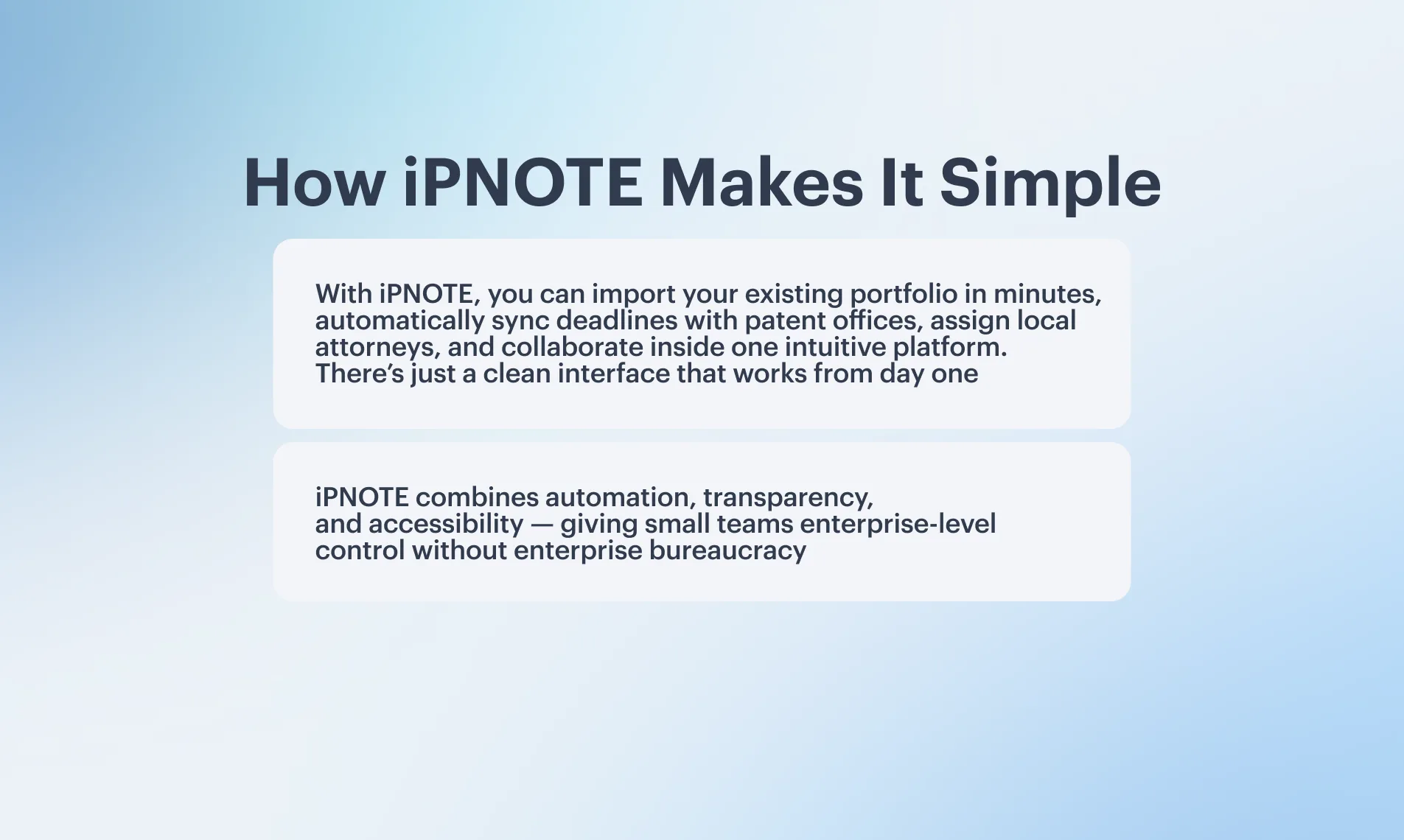
The Economics: How the Software Pays for Itself
Automation saves money.
Missed deadlines, refilings, and agency errors are expensive, and docketing software eliminates those costs. Teams report up to 60% fewer manual actions and near-perfect on-time performance after implementation.
By consolidating all data in one place, you gain full visibility into spend by jurisdiction, identify high-cost areas, and forecast renewal peaks in advance.
Within months, the return becomes clear: less time wasted, fewer errors, and a leaner, more efficient IP operation.
Real-World Wins
A typical patent family includes about 15 national or regional applications. If a company files 20 families per year, then over three years it’s already handling roughly 900 active applications.
Each of those receives at least one office action annually — that’s 900 office actions to process. Even if summarizing one takes just an hour, that’s 900 hours of work, or nearly six months of full-time effort from one employee. Six months spent not drafting, not strategizing — just summarizing. It’s an overwhelming waste of time and resources.
Now imagine replacing that routine with automation. Modern docketing software eliminates the mechanical overhead so teams can focus on real IP strategy.
- Scale-up (300+ cases/year): reduced manual workload by 60% and achieved 98%+ on-time compliance.
- Migration from agency: switched to iPNOTE in 3 weeks, no missed deadlines, 25% savings on renewal fees in the first cycle.
- Global portfolio: one consolidated dashboard for the CFO — 12-month budget forecast and region-by-region cost transparency.
How to Choose the Right Solution for Your Growth
- Small team (≤2 FTE): Start with core docketing — automate reminders, deadlines, and document storage.
- Growth company: Add integrations (e-billing, DMS), dashboards, and KPI tracking for multi-agent management.
- Enterprise: Expand into full IPMS with SSO, custom analytics, and API connectivity for end-to-end IP lifecycle control.
The key is not to overcomplicate your setup from the start — choose a platform that grows with you.
Conclusion: From Chaos to Control
Beyond saving time, patent docketing software helps build an IP process that grows with your company — structured, reliable, and completely transparent.
It helps teams focus on innovation instead of administration, keeping every filing, renewal, and action on track automatically.
What to do today:
Upload 10–20 cases into a sandbox or free freemium account. Test the reminders, deadlines, and reports on your real data.
See how much time you can save in a single week and how quickly the chaos disappears.
With iPNOTE, you get transparent pricing, instant setup, and smooth integration with your existing tools. A smarter way to manage intellectual property at scale.






